Factor-based smart beta ETF strategies have quickly gained popularity as investors look to rules-based indexing methodologies to enhance returns and minimize drawdowns.
For example, some are embracing so-called wide moat smart beta ETF strategies to access many quality global companies, such as the VanEck Vectors Morningstar Wide Moat ETF (NYSEArca: MOAT).
“MOAT is a great one that has a timeless investment philosophy built behind it,” Ed Lopez, Head of ETF Product, Vaneck, said at Inside ETFs 2019. “It basically finds great companies and buys them at a great price. There’s actually one other step to that – which we’ve really been talking about, which is process. So, buying great companies. Buy them at a great price. Do it over and over and over again.”
MOAT implements Morningstar’s economic moat rating to identify strong companies with wide economic moats. Additionally, VanEck offers other “wide moat” ETF strategies, including the VanEck Vectors Morningstar International Moat ETF (NYSEArca: MOTI), which takes a similar moat rating methodology to select overseas component holdings. The more recently launched VanEck Vectors Morningstar Global Wide Moat ETF (GOAT) implements its economic moat indexing methodology with an all-encompassing global exposure.
The economic moat investment strategy can help investors achieve improved long-term, risk-adjusted return by focusing on quality companies that help limit downside risk while still participating in potential gains.
The Morningstar Economic Moat Rating methodology assign an economic moat rating to companies, but it also focuses on those that show attractive valuations or are more attractively priced. Beyond factor effects, stock selection is also an important driver as the underlying indices combine both quality and valuation to help investors potentially generate improved returns.
According to Morningstar’s indexing methodology, there are five sources of economic moats: Intangible assets that include brand recognition to charge premium prices. Switching costs that make it too expensive to stop using a company’s products. Network effect that occurs when the value of a company’s service increases as more use the service. A cost advantage helps companies undercut competitors on pricing while earning similar margins. Lastly, efficient scale associated with a competitive advantage in a niche market.
An investor would end up with the most attractively priced stocks among the companies that have garnered the “wide moat” rating.
Watch the full interview between ETF Trends CEO Tom Lydon and Ed Lopez:
For more ETF-related commentary from Tom Lydon and other industry experts, visit our video category.







